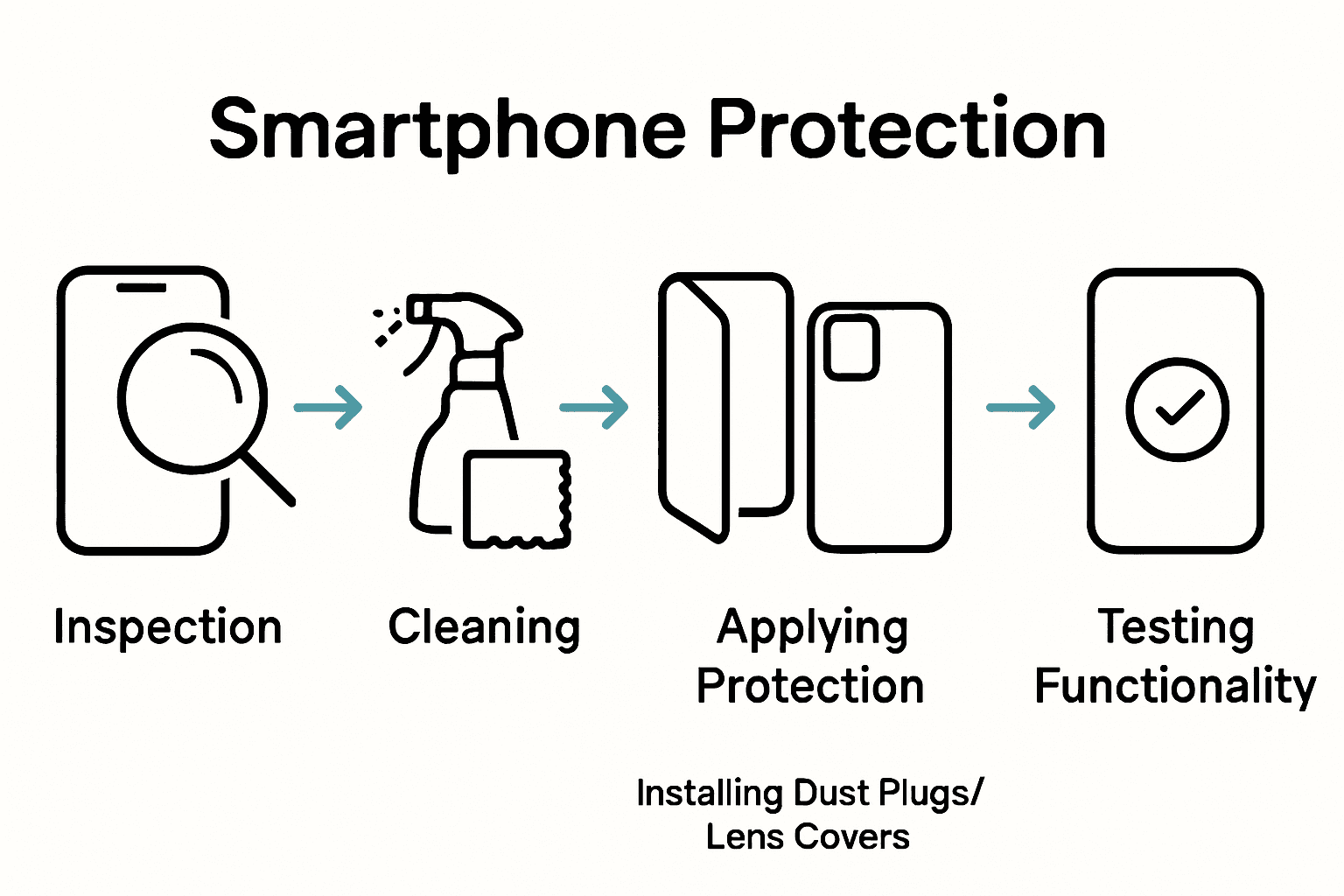
Phone Gadget Protection Steps for Reliable Device Safety
Share
Over half of smartphones show signs of minor damage within the first year of use. Every new scratch or speck of dust risks both appearance and functionality, which makes proactive protection more important than ever. Whether you’re dealing with micro-fractures or trying to keep germs at bay, knowing how to spot vulnerabilities and safeguard your device keeps it running smoothly and looking sharp. Learn the practical steps to prepare, clean, and reinforce your phone for long-lasting reliability.
Table of Contents
- Step 1: Assess Device Vulnerabilities And Prepare Surface
- Step 2: Clean Your Phone And Accessories Thoroughly
- Step 3: Apply Protective Case And Screen Guard Correctly
- Step 4: Install Dust Plugs And Lens Covers As Needed
- Step 5: Test Protection And Check Device Functionality
Quick Summary
| Key Point | Explanation |
|---|---|
| 1. Assess device vulnerabilities first | Examine your smartphone for scratches, cracks, or stressed areas to identify protection needs and prevent further damage. |
| 2. Clean with appropriate techniques | Power down, remove cases, and use a damp microfiber cloth to safely clean your device, avoiding moisture entry into openings. |
| 3. Apply protective accessories carefully | Ensure clean surfaces and proper alignment when applying screen guards and cases to maximize protection and maintain functionality. |
| 4. Use dust plugs and lens covers | Protect exposed ports and camera lenses with high-quality plugs and covers to prevent debris and scratches; inspect for wear regularly. |
| 5. Test device functionality after protection | After applying protection, check all device functionalities—buttons, touchscreen, and cameras—to ensure normal operation without interference. |
Step 1: Assess device vulnerabilities and prepare surface
Understanding your smartphone’s vulnerabilities is the first critical step in effective device protection. According to Ulster University, assessing potential contamination risks requires a systematic approach to identifying high-risk areas and potential damage points on your mobile device.
Start by carefully examining your phone’s exterior for existing scratches, cracks, or wear patterns. Pay close attention to the screen, edges, ports, and any areas prone to impact or moisture exposure. As research from Nottingham University suggests, identifying these potential vulnerabilities helps you develop a targeted protection strategy. Look for signs of stress like micro-fractures around charging ports, camera lenses, or speaker grilles that might compromise your device’s structural integrity.
One practical tip is to use natural daylight or a bright lamp when conducting your assessment. This helps reveal subtle imperfections you might miss under standard indoor lighting. Your goal is creating a comprehensive snapshot of your device’s current condition before implementing any protective measures. Knowing exactly what vulnerabilities exist allows you to select the most appropriate protective solutions and prevent further potential damage.
Step 2: Clean your phone and accessories thoroughly
Thoroughly cleaning your phone and accessories is crucial for maintaining device hygiene and protecting your investment. According to Apple Support, proper cleaning requires specific techniques to prevent potential damage while effectively removing dirt and germs.
Begin by powering down your device and removing any protective cases. As recommended by Samsung Support, use a soft microfiber cloth slightly dampened with distilled water or a specialized electronics cleaning solution. Gently wipe the device surface, paying extra attention to high touch areas like screen edges, buttons, and camera lenses. Be extremely careful to avoid moisture entering any device openings such as charging ports or speaker grilles.
One critical warning is to never spray liquid directly onto your phone or use harsh chemical cleaners that might strip protective coatings. Your cleaning cloth should be barely damp not soaking wet. For phone accessories like cases, screen protectors, and charging cables, use similar gentle cleaning methods and allow all items to completely air dry before reassembling. When done correctly, this process helps maintain your device’s appearance and functionality while reducing potential contamination risks.

Step 3: Apply protective case and screen guard correctly
Protecting your smartphone requires carefully applying the right accessories to prevent potential damage. According to CCMA, proper application of protective cases and screen guards is essential for ensuring device longevity and maintaining optimal functionality.
Start by thoroughly cleaning your device surface before installation. Remove any dust or fingerprints using a microfiber cloth to create a pristine base for your accessories. When applying a screen guard, work slowly and methodically. Begin at one edge of the screen, aligning the protector precisely and using gentle pressure to eliminate air bubbles. Move systematically across the surface, smoothing out any potential trapped air or imperfections. For protective cases, ensure a snug fit that covers all device edges and critical impact points without obstructing ports or buttons.
One critical tip is to purchase accessories specifically designed for your phone model to guarantee perfect alignment and maximum protection. Always handle screen guards with clean hands and work in a dust-free environment to prevent microscopic particles from becoming trapped underneath. The goal is a seamless installation that provides robust protection without compromising your device’s aesthetic or functionality. With careful application, your smartphone will be well-protected against everyday wear and potential accidental damage.
Step 4: Install dust plugs and lens covers as needed
Protecting your device’s most vulnerable openings requires careful attention to detail and strategic accessory placement. According to The Merchandise Lab, dust plugs and lens covers are essential tools for preventing debris and potential damage to critical device components.
Begin by carefully examining your device for exposed ports such as charging sockets, headphone jacks, and speaker grilles. Select dust plugs that precisely match your device’s specific port sizes and configurations. When installing, ensure a snug fit without applying excessive force that might damage the port or plug mechanism. For camera lens protection, choose covers that are designed specifically for your phone model, offering a secure yet easily removable solution that shields delicate lens surfaces from scratches, dust, and potential impact.
One critical warning is to regularly inspect your dust plugs and lens covers for wear or damage. Cheap or ill-fitting accessories can potentially introduce more harm than protection. Always purchase high-quality accessories from reputable manufacturers, as recommended by CCMA, to ensure your device remains safeguarded against environmental contaminants. When not in use, store these protective accessories in a clean, dry place to maintain their integrity and effectiveness.
Step 5: Test protection and check device functionality
After implementing comprehensive protection strategies, thoroughly evaluating your device’s performance becomes crucial. According to Ulster University, systematic testing helps confirm that protective measures have not compromised your smartphone’s core functionality.
Start by powering on your device and conducting a comprehensive functionality check. Test all physical buttons, touchscreen responsiveness, camera functions, speaker volume, and audio quality. Verify that protective accessories like screen guards and cases do not interfere with charging ports, speakers, or camera lenses. Pay special attention to any potential restrictions in button press sensitivity or touchscreen responsiveness caused by newly applied protective layers. As recommended by Nottingham University, ensure that each protective element allows full device operability without introducing new limitations.
One critical tip is to perform these tests under different lighting conditions and interact with various apps to simulate real world usage scenarios. Check wireless connectivity, Bluetooth pairing, and cellular signal strength to confirm that protective accessories have not created unexpected interference. Your goal is achieving maximum device protection while maintaining 100% operational integrity. If you notice any performance irregularities, carefully readjust your protective accessories or consult a professional technician for precise calibration.
Protect Your Phone with Confidence and Style
Every smartphone deserves reliable protection that addresses its unique vulnerabilities without sacrificing style or usability. The article highlights how crucial it is to identify weak spots like screen edges and charging ports and to carefully apply protective gear such as screen guards and cases to keep your device safe. If you want to avoid the stress of cracked screens or damaged ports, acting now is essential.

Explore our range of expertly designed Screen Protectors for precise, bubble-free fit alongside durable cases that safeguard your phone from everyday knocks and dust.

Get ahead of potential damage by choosing from our Our Bestsellers where quality meets innovation, ensuring your device stays flawless. Start your journey to full device safety today at StudioShake and enjoy peace of mind knowing your phone is shielded by trusted accessories tailored just for you.
Frequently Asked Questions
How can I assess vulnerabilities on my smartphone?
Start by inspecting your phone’s exterior for scratches, cracks, and wear, focusing on high-impact areas like the screen and ports. Use bright lighting to reveal imperfections and create a complete overview of your device’s condition.
What are the best practices for cleaning my phone?
Power down your device and remove any cases. Use a soft microfiber cloth slightly dampened with distilled water or an electronics cleaning solution to gently clean the surface, ensuring moisture doesn’t enter any openings.
How do I properly apply a screen guard?
Begin by cleaning your device’s surface with a microfiber cloth to eliminate dust and fingerprints. Align the screen guard precisely with one edge and press gently to remove air bubbles as you apply it across the screen.
What should I consider when installing dust plugs and lens covers?
Select dust plugs and lens covers that match your device’s specific ports and lens sizes. Ensure a snug fit without applying excessive pressure, and regularly check for wear or damage to maintain good protection.
How can I test the effectiveness of my device protection?
Power on your phone and check all functions, including buttons, touch responsiveness, and camera operations. Interact with various apps and test wireless connectivity to ensure protective accessories are not hindering performance.
What actions can I take if my device functionality is affected after applying protective accessories?
If you notice performance issues, carefully readjust your screen guard or case. If problems persist, consult a technician for proper calibration to restore device functionality.
